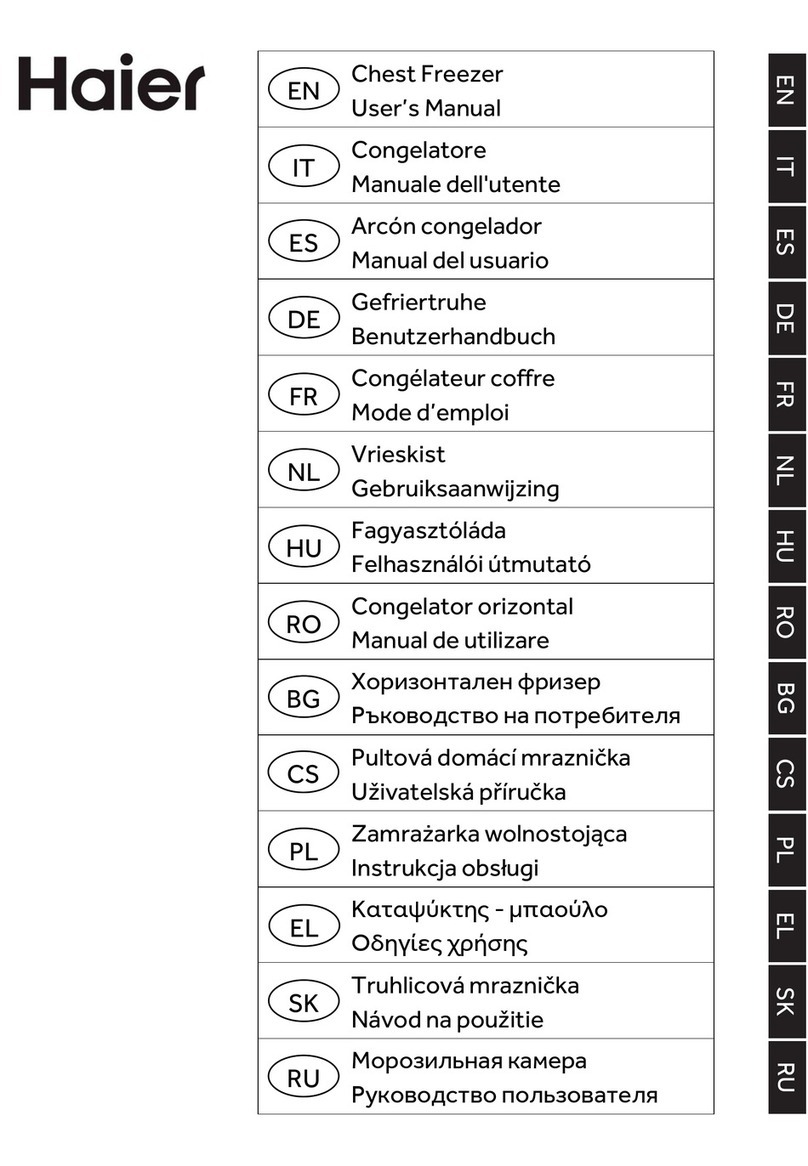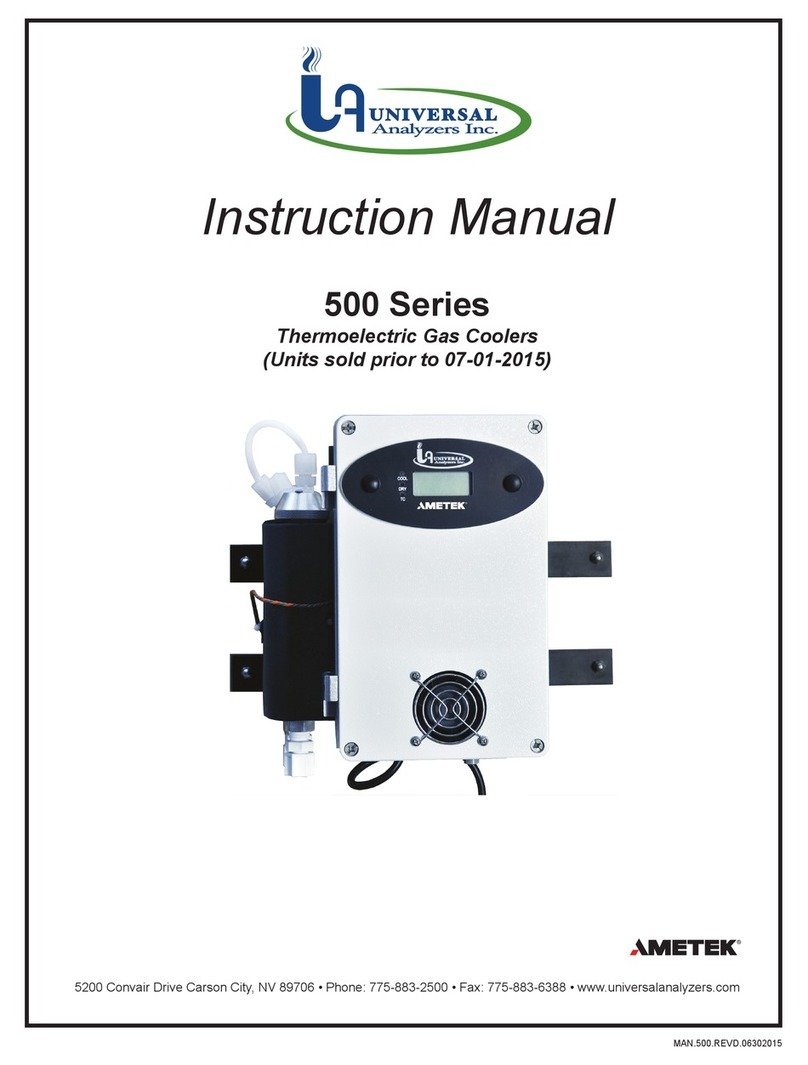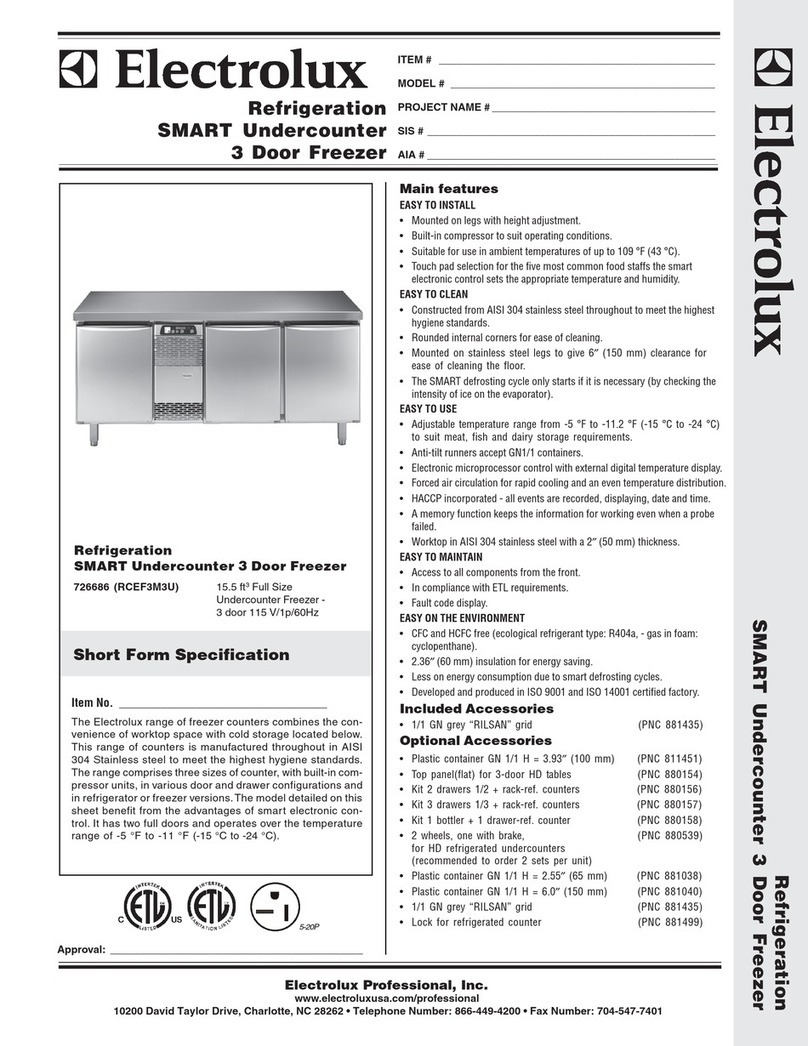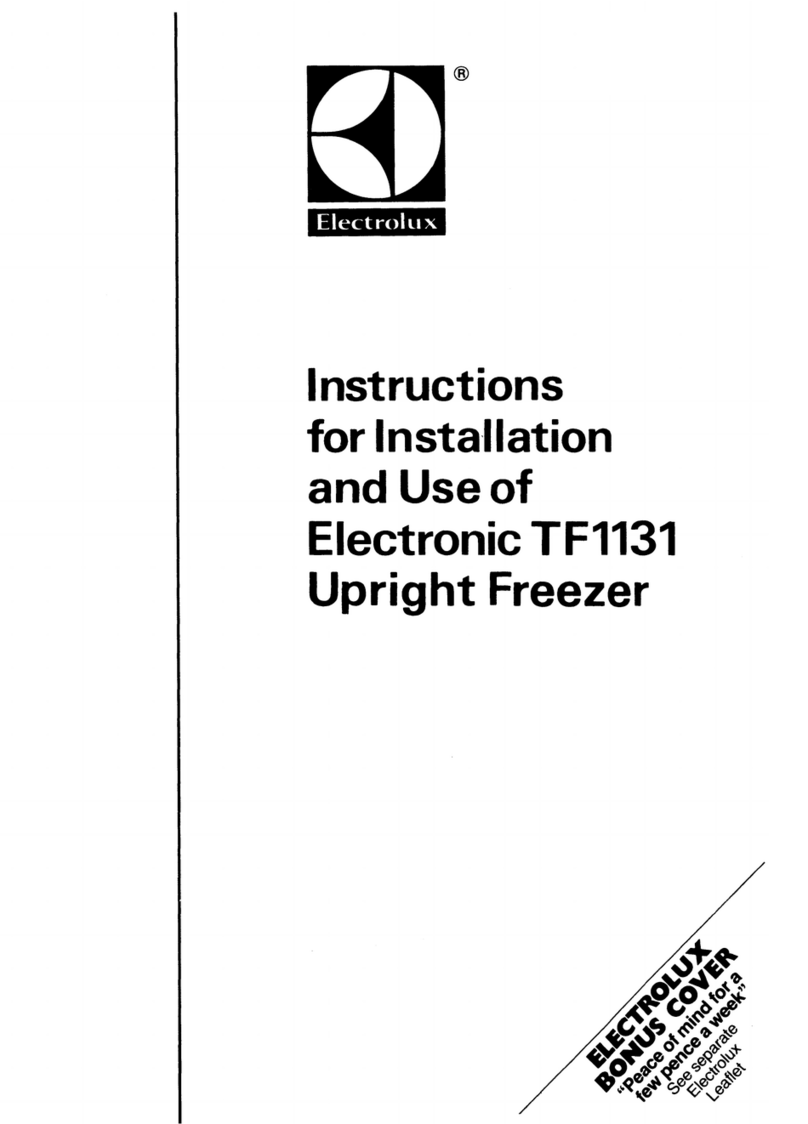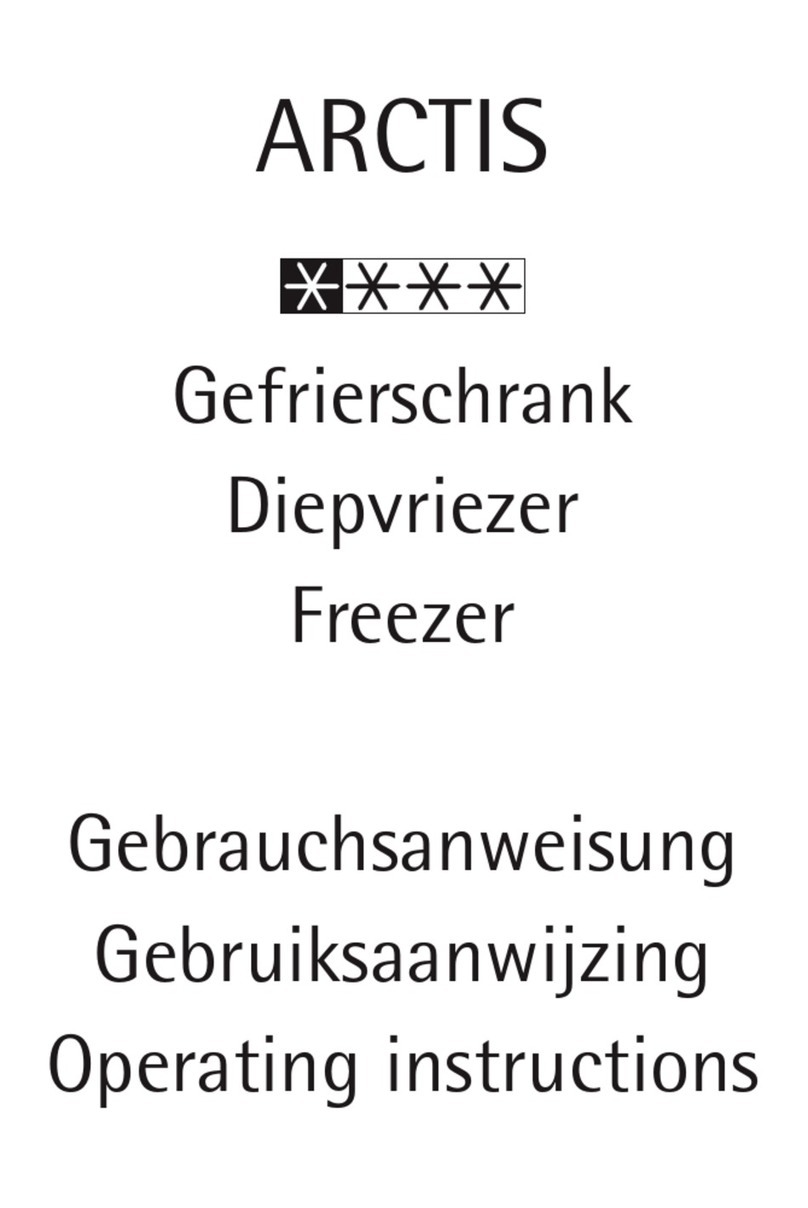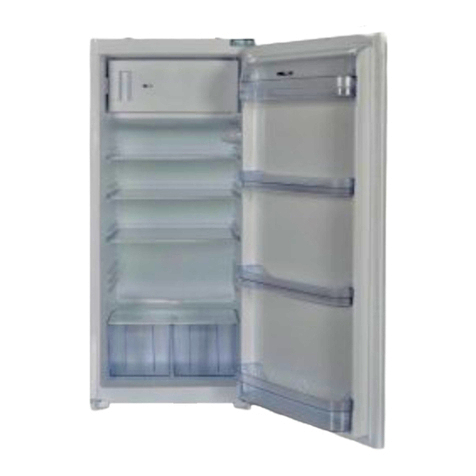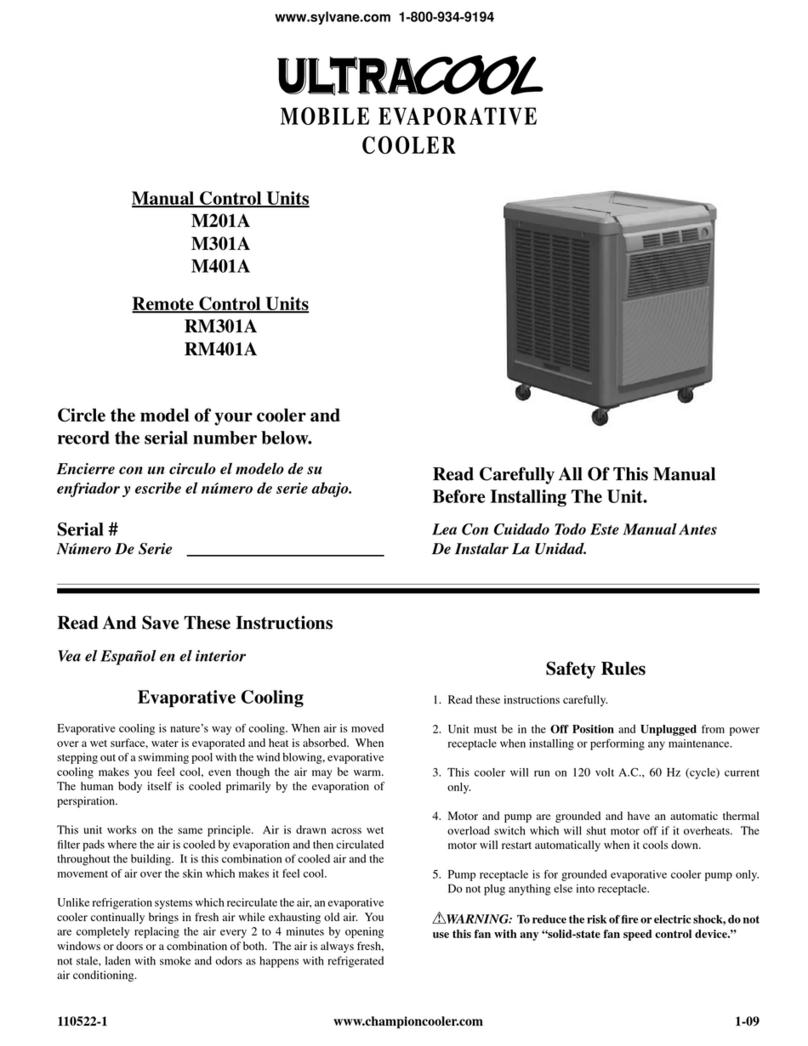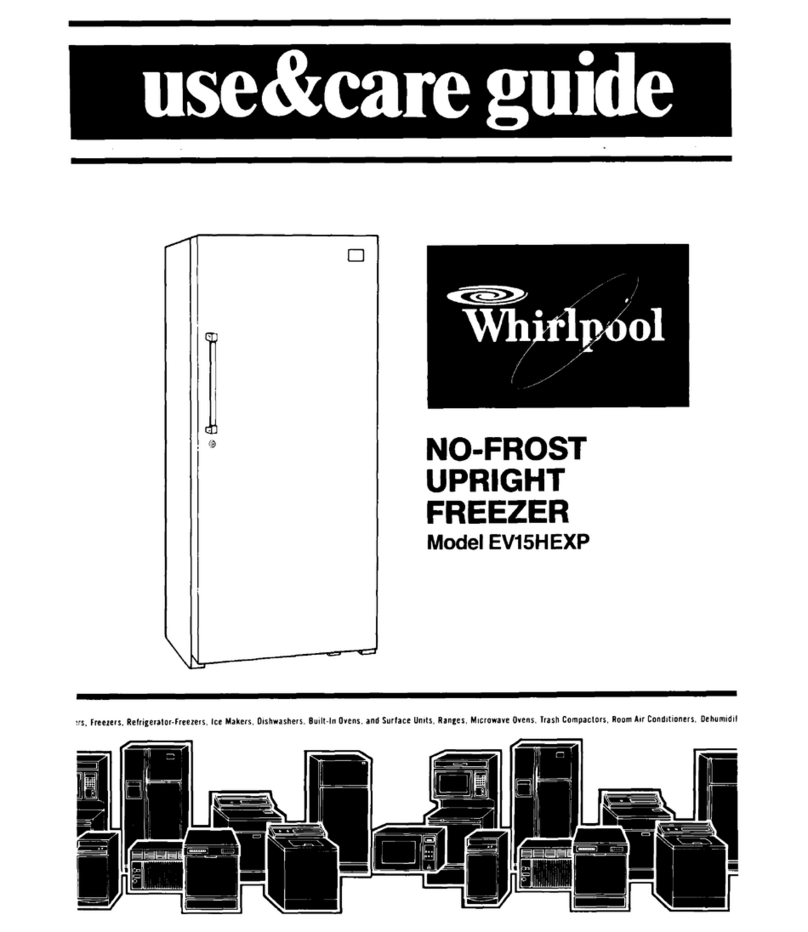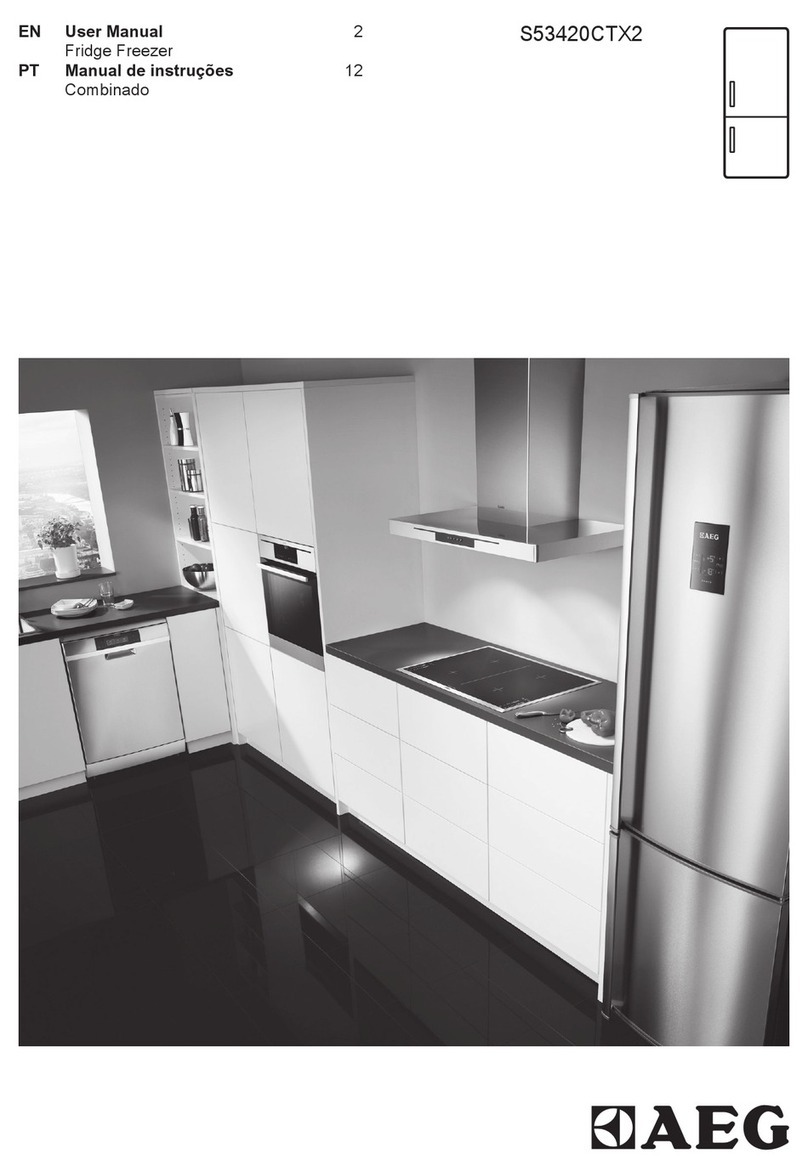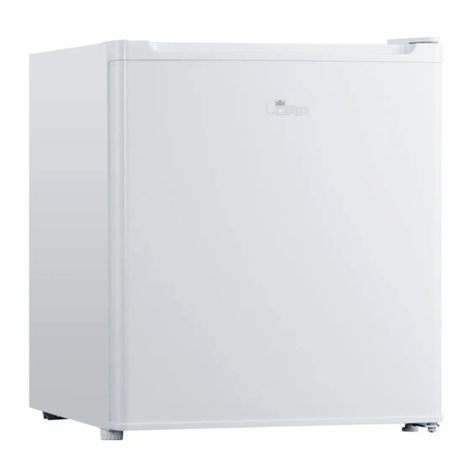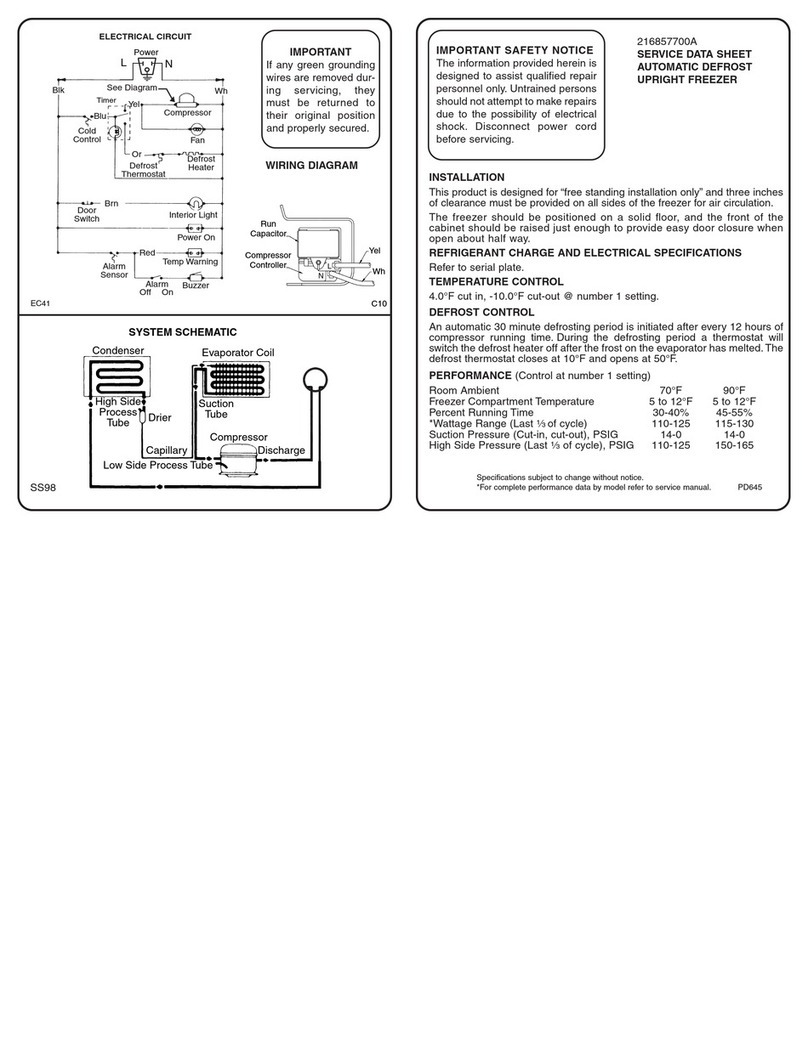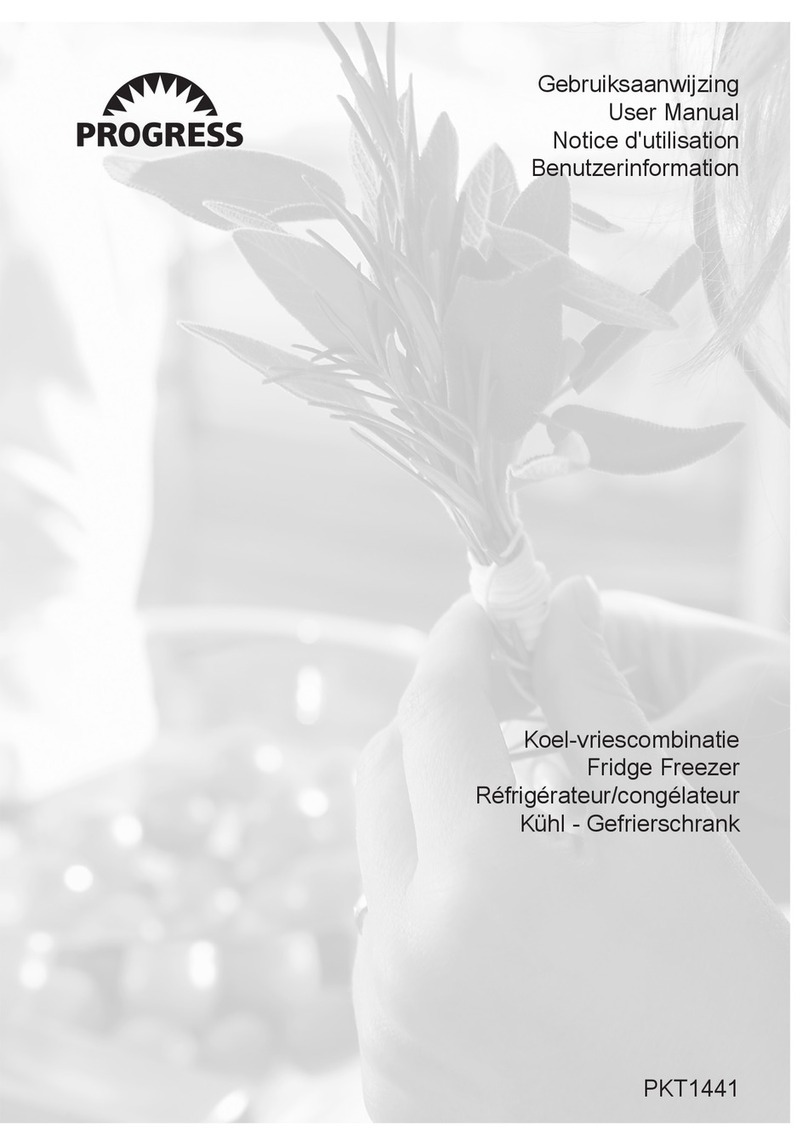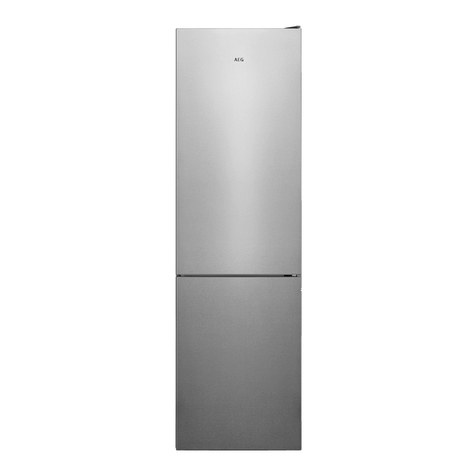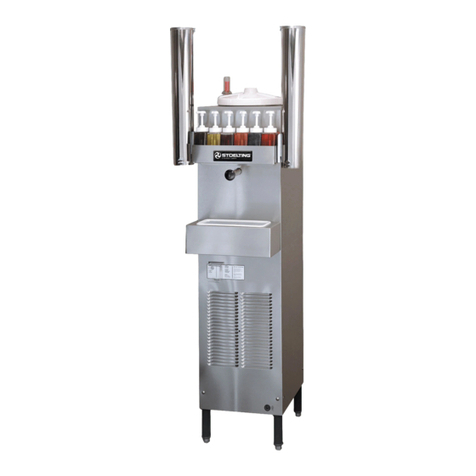Brada Appliances WS-180FFZ User manual

INSTRUCTION MANUAL
Freezer
WS-180FFZ
Before use, please read this manual carefully.

1
Dear customer:
Thank you for buying your new freezer. To ensure that you get the best results from your new freezer,
please take time to read through these simple instructions in this booklet.
Please ensure that the packaging material is disposed of in accordance with the current environmental
requirements.
If the freezer is visibly damaged, do not connect it to the power supply, Contact the store from were you
purchased the appliance.
CONTENTS
Important safety instructions ………………………………………………………………………..2
Before Putting Into Use………………………………………………………………………………3
Tips for Energy Savings ……………………………………………………………………………..3
Important……………………………………………………………………………………………….3
Names of the parts……………………………………………………………………………………4
How to operate…………………………………………………………………………………………5
Temperature control…………………………………………………………………………………...5
How to Defrost………………………………………………………………………………………….5
How to clean……………………………………………………………………………………………5
How to install …………………………………………………………………………………………..6
What to do……………………………………………………………………………………………...6
CHANGING THE REVERSIBLE DOOR…………………………………………………………… 7
How to dispose of the packing materials …………………………………………………………...7

2
IMPORTANT SAFETY INSTRUCTIONS
To reduce the risk of fire, electrical shock, or injury
follow these basic precautions when using your
refrigerator.
1) WARNING----Keep ventilation openings, in the appliance enclosure or in the built-in
structure, clear of obstruction.
2) WARNING----Do not touch the interior of the chiller compartment with wet hands. This
could result in frost bite.
3) WARNING----Do not use mechanical devices or other means to accelerate the defrosting
process, other than those recommended by the manufacturer.
4) WARNING----Do not damage the refrigerant circuit when handling, moving, or using the
refrigerator.
5) WARNING----Do not use electrical appliances inside the food storage compartment of the
refrigerator, unless they are of the type recommended by the manufacturer.
6) WARNING----DANGER: Never allow children to play with, operate, or crawl inside
refrigerator.
Risk of child entrapment. Before you throw away your old refrigerator:
•Take off the doors
•Leave the shelves in place so that children may not easily climb inside.
7) Unplug the refrigerator before carrying out user maintenance on it.
8) This appliance is not intended for use by persons (including children) with reduced
physical, sensory or mental capabilities, or lack of experience and knowledge, unless they
have been given supervision or instruction concerning use of the appliance by a person
responsible for their safety. Children should be supervised to ensure that they do not play
with the appliance.
9) If a component part is damaged, it must be replaced by the manufacturer, its service
agent, or similar qualified persons in order to avoid a hazard.
10) Please dispose of the refrigerator according to local regulations as the refrigerator
contains flammable gas and refrigerant..
11) Follow local regulations regarding disposal of the refrigerator due to flammable refrigerant
and gas. All refrigeration products contain refrigerants, which under the guidelines of
federal law must be removed before disposal. It is the consumer's responsibility to comply
with federal and local regulations when disposing of this product.
12) This refrigerator is intended to be used in household and similar environments.
13) Do not store or use gasoline or any flammable liquids inside or in the vicinity of this
Refrigerator.
14) Do not use extension cords or ungrounded (two prong) adapters with this refrigerator. If
the power cord is too short, have a qualified electrician install an outlet near the
refrigerator. Use of an extension cord can negatively affect the refrigerator’s performance.
15) If the supply cord is damaged, it must be replaced by the
manufacturer, its service agent or similarly qualified person
in order to avoid a hazard.

3
Before Putting Into Use
Before connecting the appliance to the power supply, let it stand for about 2 hours, which will
reduce a possibility of malfunctions in the cooling system due to transport handling.
Clean the appliance, and be thorough, especially in the interior (See “HOW TO CLEAN”).
In case the interior accessories are not correctly placed, rearrange them as described in chapter
“NAME OF THE PARTS”.
Instructions for Use
These instructions for use are intended for the user. They describe the appliance and its correct and
safe use. They were prepared for various types/models of fridges therefore you may find in it
description of some functions and accessories that your appliance does not have.
Tips for Energy Savings
Tips for Energy Saving
Try not to open the door too often, especially when the weather is humid and hot. Once you open
the door, close it as soon as possible.
Every now and then check if the appliance is sufficiently ventilated (adequate air circulation around
the appliance).
Set thermostat from higher to lower settings as soon as possible (depends on how loaded the
appliance is ambient temperature etc).
Before loading the appliance with packages of fresh foods, make sure they are cooled to ambient
temperature.
Ice and frost layer increase energy consumption, so defrost the appliance as soon as the layer is
1/8” thick.
Important
DANGER: Risk of child entrapment. Before you throw away your old appliance
Take off the doors.
Leave the shelves in place so that children may not easily climb inside.
The appliance must be correctly connected to the power supply. (See: “HOW TO INSTALL”).
Do not use an extension cords or ungrounded (two prong) adapters..
Do not touch the cooled surfaces while the appliance operates, especially not with wet
hands, because the skin may stick to the cold surfaces.
Do not freeze bottles containing liquid, especially soft drinks, such as mineral water,
sparkling wine, beer, cola etc., because liquid expands during freezing and the glass bottle is
very likely to blow up.
Disconnect the appliance from the power supply before repairing it (only a qualified
technician should repair it), before cleaning.
Do not defrost the appliance with other electric devices (hair dryer etc.) and never scrape the
ice or frost layer with sharp tools.
The rating plate is inside the appliance or outside on the rear wall.

4
NAMES OF THE PARTS
1. Temperature Control Box
2. Drawer
3 .Lower drawer
4. Adjustable legs
5.Top hinge cover
6. Hole button of door
7.Magnetic Gasket
8.Bottom hinge
9.Door stopper

5
HOW TO OPERATE
Starting Your New Freezer
1. Clean the freezer thoroughly. Wipe the outside with a soft dry cloth, the interior with a clean moist
cloth.
2. Insert the power supply cord into the socket.
3. Turn the thermostat dial to “7”. Close the door and let the fridge operate for 15-20 minutes.
Temperature Control
To control the internal temperature, adjust the thermostat dial. “1” is the warmest setting. “7” is the
coldest. The Dial may be set any place on the scale. It does not have to be set exactly on a number.
Note: Wait 3-5 minutes before restarting if you unplug the fridge.
The unit may fail to operate properly if restarted too quickly.
How To Defrost
Defrost the fridge when the frost accumulated on the evaporator is about 1/8” thick.Set the thermostat
dial to “OFF”or “0”to defrost. Remove all contents from the freezer compartment. Leave the freezer
door open to allow accumulated ice/frost to melt. Remove large pieces of ice as need. Do not use hot
water or other electric heating devices to melt the accumulated ice. After defrosting, remove
accumulated ice/water and wipe the freezer compartment with a soft cloth. Restart the unit per starting
instructions.
Never use a knife or other sharp instrument to scrape ice/frost from the inside of the unit.
HOW TO CLEAN
Cleaners: Never use harsh, abrasive cleaners, heavy-duty cleaners, or solvents on any surface.
Exterior: Wipe with damp, sudsy cloth, rinse and dry.
Interior: Wash shelves and other removable parts in warm sudsy water, rinse and dry. Wash interior
with baking soda solution (3 tablespoons to I liter of water) or warm sudsy water, rinse and
dry.
Magnetic Door Seals: Wash with warm sudsy water.
The Finishing Touch: Replace all parts and return thermostat dial to desired setting.

6
HOW TO INSTALL
Install freezer in a convenient location away from extreme heat and cold. Allow sufficient clearance
between the fridge and side wall so the door will open without obstruction. Freezer is not designed for
recessed installation.
Select a space with strong level floor.
Allow 5 inches of space between the freezer’s side and the wall.
The appliance must be correctly connected to the power supply.
POWER CORD REPLACEMENT
If the freezer’s power cord is damaged, have it replaced by a
qualified repair agent.
WHAT TO DO …
When the freezer is not in use for a prolonged period:
Remove the power plug from the wall outlet.
Remove all contents from the freezer.
Dry the interior and leave the door open for a few days.
When you wish to move the freezer:
Secure all movable parts and contents. (Package them separately if necessary.)
Transport the freezer only in an upright position. In any other position you may damage the
compressor.
Before calling service, please follow the checklist below.
This may save you an expensive service call.
If the freezer seems too warm inside:
Check that the door has not been opened too frequently or for long.
Check that the interior circulation is not obstructed by having too many goods stored. (The fridge is
overloaded)
Did you store anything hot, without first cooling it to room temperature?
Is there sufficient clearance around all sides and above the freezer?
If the appliance starts making any unusual noises:
Is it wobbling? Re-level it and check if it now operates normally.
Have any objects fallen behind the freezer? If so, remove them and check if operation is now
normal.
Are any containers inside the freezer vibrating or resonating? If so, rearrange them then check to
see if operation has returned to normal.

7
CHANGING THE REVERSIBLE DOOR
CAUTION: To avoid personal injury to yourself and/or property, we recommend
someone assist you during the door reversal process.
1. Remove the top hinge cover by unscrewing the screws that fix it.
2. Pull the door upwards to remove it from lower hinge.
3. Tilt the cabinet backwards to remove lower hinge and two adjustable feet.
4. Move the lower hinge to the opposite side and secure it, along with the 2 adjustable feet.
5. Position and slot the door onto the lower hinge.
6. Remove the plug cover (covering the hinge hole) on the top of the door frame, then secure the top
door hinge cover on the same side of the door as the lower hinge.
The reversal process is now complete.
HOW TO DISPOSE OF THE PACKING MATERIAL
The packing material is recyclable.
The following procedure is recommended:
- dispose of paper, card and carton in the relative containers;
- dispose of plastics in the relative containers.
- If you have no recycling bins in your area then you can put this material in the ordinary bins and/or
take it to the appropriate collection centers.
DISPOSAL :Do not dispose this product as unsorted municipal waste.
Collection of such waste separately for special treatment is necessary.
Meaning of crossed-out wheeled dustbin: Do not dispose of electrical
appliances as unsorted municipal waste, use separate collection facilities.
Contact you local government for information regarding the collection systems
available.
If electrical appliances are disposed of in landfills or dumps, hazardous
substances can leak into the groundwater and get into the food chain, damaging your health and
well-being.

Guide d'utilisation
Congélateur
WS-180FFZ
Veuillez lire attentivement cette notice avant l’installation et avant la première utilisation de cet
appareil. Conservez la notice en lieu sûr.

1
Félicitation:
Merci d’avoir acheté ce nouveau congélateur. Afin d’obtenir les résultats et performances souhaités; il
suffit de lire attentivement les instructions qui figurent dans cette notice.
Assurez-vous de disposer du matériel d’emballage selon les normes environnementaux requis. Si le
congélateur est endommagé, veuillez ne pas le brancher. Veuillez-vous renseigner auprès du magasin
où l’achat a été effectué.
TABLE DES MATIÈRES
INFORMATION DE SECURITÉ IMPORTANT ................................................................................ 2
AVANT UTILISATION ......................................................................................................................3
CONSEILS POUR RÉDUIRE VOTRE CONSOMMATION D’ENERGIE .........................................3
IMPORTANTES ...............................................................................................................................3
DESCRIPTION DES PIÈCES ..........................................................................................................4
UTILISATION ET ENTRETIEN ........................................................................................................5
CONTROLE DE LA TEMPÉRATURE ..............................................................................................5
DÉGIVRAGE ................................................................................................................................... 5
NETTOYAGE ...................................................................................................................................5
INSTRUCTIONS D’INSTALLATION ................................................................................................6
REMPLACEMENT DE CORDON D’ALIMENTATION .....................................................................6
QUOI FAIRE ....................................................................................................................................6
INVERSER LE SENS DE L’OUVERTURE DE LA PORTE ............................................................. 7
COMMENT DISPOSER DU MATÉRIEL D’EMBALLAGE ............................................................. ..8

2
INFORMATIONS DE SÉCURITÉ IMPORTANTES
Afin de réduire les risques d'incendie, de choc
electrique ou de blessure, veuillez suivre ces
précautions de base lors de l’utilisation de votre appareil.
1) AVERTISSEMENT---- Conserver les ouvertures d'aération dans l'emplacement de
l'appareil ou dans une structure intégrée àl'abri de toute obstruction.
2) AVERTISSEMENT---- Ne pas toucher l'intérieur du compartiment de refroidissement avec
des mains humides. Cela pourrait être cause d'une engelure.
3) AVERTISSEMENT---- Ne pas utiliser d'appareils mécaniques ou d'autres méthodes pour
accélérer le processus de décongélation, autres que celles indiquées par le fabricant.
4) AVERTISSEMENT---- Ne pas endommager le circuit du réfrigérant lors de la manipulation,
du déplacement ou de l'utilisation du réfrigérateur.
5) AVERTISSEMENT---- Ne pas utiliser d'appareils électroménagers àl'intérieur du
compartiment de stockage d'aliments du réfrigérateur, sauf s'ils sont du type recommandé
par le fabricant.
6) AVERTISSEMENT--DANGER--- Ne jamais laisser les enfants jouer avec, faire fonctionner
ou grimper dans le réfrigérateur.
Risques de piégeage de l'enfant. Avant de mettre au rebus l'ancien réfrigérateur :
•Enlever les portes;
•Laisser les étagères en place pour éviter que les enfants n'y grimpent àl'intérieur
facilement.
7) Laisser les étagères en place pour éviter que les enfants n'y grimpent àl'intérieur
Facilement.
8) Cet appareil n'est pas conçu pour être utilisépar des personnes (y compris des enfants)
à
capacités physiques, sensorielles ou intellectuelles réduites ou sans expérience et
connaissances, àmoins qu'ils soient sous surveillance ou bien qu'ils aient étéinformées
quant àl'utilisation de l'appareil de manière sûre, par une personne responsable de leur
sécurité. Les enfants doivent être surveillés pour vérifier qu'ils ne jouent pas avec
l'appareil.
9) Si une pièce ou un élément a étéendommagé, il doit être remplacépar le fabricant, son
service d'assistance technique ou d'autres personnes disposant des qualifications
requises, afin d'éviter tout danger.
10) Disposer du réfrigérateur conformément àla réglementation locale car ce dernier
contient du gaz et du réfrigérant inflammable.
11) Suivre la réglementation locale concernant la mise au rebut du réfrigérateur en raison du
gaz et du réfrigérant inflammables. Tous les appareils de réfrigération
contiennent des réfrigérants qui doivent être, sous les directives de la loi fédérale,
éliminés avant la mise aux rebut. C'est la responsabilitédu consommateur de
se conformer àla réglementation fédérale et locale lors de la mise au rebut de
cet électroménager.
12) Ce réfrigérateur est prévu pour une utilisation àdomicile et d'autres environnements
semblables.
13) Ne pas entreposer ou utiliser de l'essence ou autres liquides inflammables àl'intérieur
ou

3
àproximitédu réfrigérateur.
14) Ne pas utiliser de rallonge électrique ou d'adaptateurs non mis àla masse (deux plots)
avec ce réfrigérateur. Si le cordon d'alimentation est trop court, contacter un technicien
qualifiépour installer une prise àcôtédu réfrigérateur. L'utilisation d'une rallonge peut
avoir des effets négatifs sur le fonctionnement du réfrigérateur.
15) Si le cordon d'alimentation a étéendommagé, il doit être remplacéparle fabricant,
son service d'assistance technique ou d'autres personnes disposant des
qualifications requises, afin d'éviter tout danger.
Avant utilisation
Retirez l’emballage extérieur et intérieur.
Laissez le congélateur droit pendant deux heures avant de le brancher. Cela réduira les risques de
mauvais fonctionnement du système de refroidissement qui pourraient être provoqués suite au
transport de l’appareil.
Nettoyez l’intérieur de l’appareil à l’eau tiède à l’aide d’un chiffon doux.
Installation de l’appareil
Ces instructions sont destinées à l’utilisateur. Elles contiennent des renseignements nécessaires au
bon fonctionnement de l’appareil. Elles ont été préparées pour l ‘utilisation de plusieurs modèles de
réfrigérateur ou de congélateur .Ceci étant dit, il se pourrait qu’il y figure des informations qui ne
concernent pas ce congélateur-ci.
Conseils pour Économies en Énergie
Essayez de ne pas ouvrir la porte trop souvent, surtout quand il fait chaud et humide. Une fois que
vous ouvrez la porte, essayez de la refermer dès que possible.
Vérifiez de temps en temps que l'appareil est bien ventilé (circulation d'air suffisante autour de
l'appareil).
La couche de glace augmente la consommation d'énergie, veuillez donc dégivrer l'appareil dès
que la couche de glace / de gel accumulée est de 1/8" d'épaisseur.
Important
DANGER: Risque de piégeage des enfants. Avant de jeter votre ancien appareil :
Retirer les portes et / ou le couvercle.
Laissez les étagères en place afin que les enfants ne puissent pas grimper facilement à
l’intérieur.
L'appareil doit être correctement raccordé à l'alimentation électrique, NE PAS utiliser une rallonge.
Ne touchez pas les surfaces FROIDES ou GIVREES tandis que l'appareil fonctionne, surtout avec
les mains mouillées car la peau peut coller à la surface froide.

4
Débranchez l'appareil de l'alimentation électrique avant réparation ou entretien
Ne pas dégivrer l'appareil avec d'autres appareils électriques (sèche-cheveux, etc.) et ne jamais
gratter la couche de glace ou de givre avec des outils tranchants.
La plaque signalétique se trouve au dos de l'appareil.

5
Description des piéces
1. Contrôle de la Température
2. Tiroir
3. Tiroir inférieur
4. Pieds réglables
5. Couvercle de la charnière supérieure
6. Bouchon de porte réversible
7. Joint d'étanchéité
8. Charnière inférieure
9. Butée de porte
Utilisation et Entretien
Nettoyez soigneusement le congélateur. Essuyez l'extérieur à l’aide d’un chiffon doux et sec, et
l'intérieur à l’aide d’un chiffon propre et humide.
Insérez le cordon d'alimentation dans la prise électrique.
Tournez la molette du thermostat sur "7". Fermez la porte et laissez le congélateur fonctionner

6
pendant 15-20 minutes.
Contrôle de la température
Pour contrôler la température interne, régler le thermostat avec. "1" est le réglage le plus chaud.
"7" est le plus froid. Le cadran peut être réglé tout lieu sur l'échelle. Il n'a pas à être mis
exactement sur un certain nombre.
Remarque: Attendez 3-5 minutes avant de redémarrer si vous débranchez le congélateur.
L'appareil peut ne pas fonctionner correctement si redémarré trop rapidement.
Dégivrage
Dégivrez votre congélateur lorsque le givre accumulé sur les étagères de
l'évaporateur atteint environ 1/8" d'épaisseur. Pour décongeler, réglez le bouton du
thermostat sur "OFF" ou "0" et enlever tous le contenu du compartiment congélateur.
Laissez la porte du congélateur ouverte pour permettre à la glace accumulée de
fondre. Retirez les gros morceaux de glace au besoin. Ne pas utiliser d'eau chaude
ou d'autres appareils de chauffage électrique pour faire fondre la glace. Après
décongélation, enlever la glace/l’eau accumulée et essuyez le compartiment avec un
chiffon doux. Redémarrez l'unité par les instructions de démarrage.
Ne jamais utiliser un couteau ou un autre instrument tranchant pour gratter la
glace/le gel à l'intérieur de l'unité.
Nettoyage
Nettoyants: Ne jamais utiliser de nettoyants abrasifs, lourds ou des solvants sur une
surface quelconque.
Extérieur: Essuyer avec un chiffon humide et savonneux, rincer et sécher. Pour les
taches tenaces et un cirage périodique, utilisez de la cire de silicone.
Intérieur: Lavez les étagères et autres parties amovibles dans de l'eau chaude
savonneuse, rincez et séchez. Lavez l'intérieur avec une solution de
bicarbonate de soude (3 cuillères à soupe pour un litre d'eau) ou de l'eau
chaude savonneuse, rincez et séchez.
Joint de porte: Laver à l'eau chaude savonneuse.
Remplacer toutes les pièces et retourner le cadran du thermostat à la position
désirée.
Instructions d’installation
Installer le congélateur loin de toute source de chaleur extrême. Assurez-vous qu’il y ait assez
d’espace entre le mur et le congélateur afin que la porte puisse
s’ouvrir avec facilité. Ce congélateur n’est pas destiné à l’installation
Encastrable. Placez le congélateur sur une surface correctement
Nivelée. Laisser au moins une espace de 5 pouces entre le

7
congélateur et le mur.
Remplacement Cordon d’alimentation
Si le cordon d’alimentation est endommagé, veuillez le faire remplacer par un agent de
réparation qualifié.
QUOI FAIRE …
Si le congélateur n’a pas été utilisé pendant une longue période:
Enlever le cordon d’alimentation de la prise électrique.
Enlever le contenu se trouvant à l ‘intérieur du congélateur
Sécher l’intérieur et laisser la porte ouverte pendant quelques jours.
Lorsqu’il faut déplacer le congélateur :
Veuillez mettre en lieu sûr les pièces mobiles. (S’il le faut, mettez-les séparément.)
Transporter le congélateur en position verticale afin de ne pas endommager le
compresseur
Avant d’effectuer un appel de service, veuillez vérifier la liste ci-dessous
Elle pourrait vous éviter une dépense inutile
S’il fait trop chaud à l’intérieur du congélateur
Vérifier si la porte est bien fermée
Vérifier si l’intérieur n’est pas surchargé (Réfrigérateur trop rempli)
Si vous y aviez mis de la nourriture chaude
Y a-t-il suffisamment assez d’espace entre le congélateur et le mur
Si l’électroménager fait un bruit inhabituel :
S’il est bancal? Remettez-le à niveau et vérifier s’il fonctionne normalement
Des objets pourraient obstrués l’arrière du congélateur. .Enlevez-les et vérifier s’il
fonctionne normalement.
Inverser le Sens de la Porte
ATTENTION : Pour éviter de vous blesser et / ou votre propriété, nous recommandons
d’avoir quelqu'un pour vous aider pendant le processus d'inversion de porte.
1. Couvercle de la charnière de porte
2. Vis
3. Gond de porte

8
4. Prise
5. Couvre prise
6. Prise
7. Manchon brochée de la charnière inférieure
8. Vis
9. Charnière inférieure
10. Vis
11. Pied ajustable
Retirez le couvercle de la charnière supérieure en dévissant les vis qui le fixent.
Tirez la porte vers le haut pour le retirer de la charnière inférieure.
Inclinez l'armoire vers l'arrière pour enlever la charnière inférieure et deux pieds réglables.
Déplacer la charnière inférieure sur le côté opposé et fixez-le, ainsi que les 2 pieds réglables.
Position et fente de la porte sur la charnière inférieure.
Retirez le couvercle du bouchon (couvrant le trou de charnière) sur la partie supérieure du
cadre de la porte, puis fixez le couvercle supérieur de la charnière de porte sur le même côté
de la porte de la charnière inférieure. Le processus d'inversion est maintenant terminé.
Comment disposer du matériel d’emballage
Le matériel d ‘emballage est recyclable.
Les procédures suivantes sont recommandées
-Mettre papier, carton et cartes dans des bacs de récupération ;
- Mettre les matières en plastique dans les bacs de récupération
- Si vous ne disposez pas de bacs de récupération dans votre quartier, mettez-les dans des
bacs à poubelle.
Mise au rebut d’appareils électroménagers : Ne pas disposer de ce produit
dans les déchets municipaux non triés .Veuillez les disposer dans des
endroits prévus à cet effet.
C’est-à-dire dans les poubelles barrées d’une croix. Ne pas disposer des
appareils électroménagers dans les déchets municipaux non triés. Utiliser
de préférence un centre de collecte d’appareils électroménagers.
Contactez votre gouvernement local pour connaître les systèmes de ramassage disponibles.
Si les électroménagers sont disposés dans des décharges municipales ou des dépotoirs à ciel
ouvert, des substances dangereuses pourraient s’infiltrer dans le sol et de la sorte contaminé la
chaîne alimentaire et ainsi nuire à notre bien-être et à notre santé.
Table of contents
Languages:
